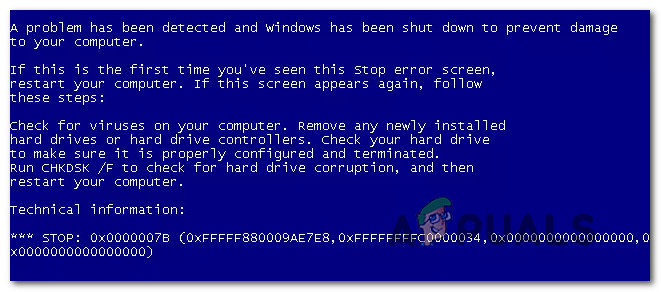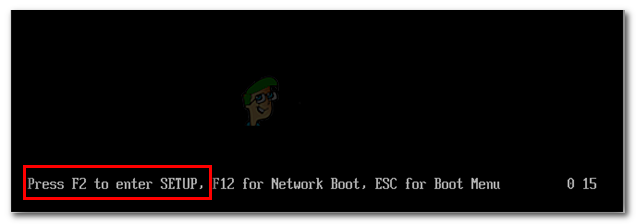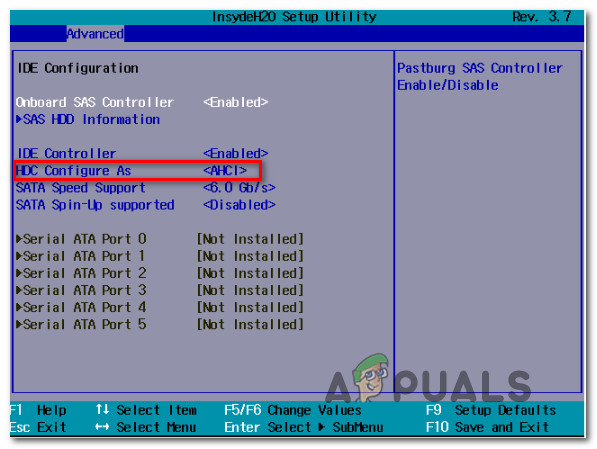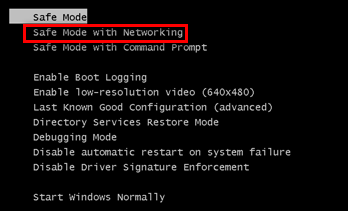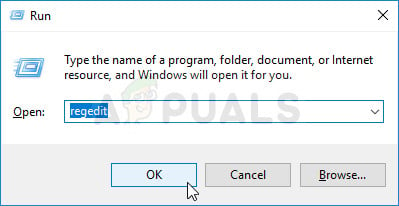What is causing the 0x0000007B BSOD Error?
We investigated this particular issue by analyzing various user reports and some popular repair strategies that affected users deployed as fixes. As it turns out, there are multiple potential culprits that might be responsible for this error: If you’re currently looking for repair strategies to resolve the 0x0000007B BSOD Error, this article will provide you with several different troubleshooting guides. Down below, you’ll find a collection of methods that other users in a similar situation have successfully used to fix this problem. To remain as efficient as possible, we encourage you to follow the potential fixes in the order that they are presented and skip the methods that are not applicable to your particular scenario. The methods below are ordered by efficiency and each of them is confirmed to work by at least one affected user. Let’s begin!
Method 1: Enabling SATA Controller Mode in BIOS
A good place to start investigating is to check if SATA controller configuration in the system gets toggled from ATA to AHCI mode (or vice versa). If this scenario is applicable, chances are Windows will not be able to communicate with the SATA controller since the two modes are using different drivers and different communication channels. Several affected users that we’re also struggling with this issue have reported that they’ve been able to resolve the issue by toggling the SATA controller mode inside their BIOS settings. Here’s a quick guide on how to do this:
Method 2: Removing the second HDD/SSD (if applicable)
As it turns out, this particular issue can also occur if have connected two different HDD (or SSD) that contain a Windows installation. In certain cases, this will confuse the Boot manager into throwing the 0x0000007B BSOD Error even in situations where there’s nothing wrong with the system partition. Several users that are also encountering this issue have reported that the BSOD error was no longer occurring after they removed/disconnected the non-essential HDD drive. If this scenario is also applicable to your current situation, remove your second HDD or SSD and see if your computer is able to boot up. In the event that the boot-up error no longer appears while the second HDD is disconnected, the only way you’ll be able to use both your HDDs or SSDs is to wipe the non-essential driver and use it as a storage drive only. You can do this easily by following our article on performing a clean install. In the event that this method wasn’t applicable to your particular scenario, move down to the next method below.
Method 3: Enabling the AHCI driver via Registry
It’s also possible that you’ll start getting a slightly different error message after you make the switch to AHCI or to RAID (STOP 0x0000007B INACCESSABLE_BOOT_DEVICE). In this particular case, the issue will occur if the disk driver on Windows 7 or Windows Vista is actually disabled. To be able to use SATA/Raid mode, you need this driver enabled. Several users have been able to resolve the issue by using the Registry Editor to enable SATA/RAID mode from a Safe Mode boot. Here’s a quick on how to do this: If the issue is still not resolved, move down to the next method below.
Method 4: Running a CHKDSK scan
It’s also possible that this issue is occurring due to system file corruption. This might end up affecting the booting sequence, which might trigger a 0x0000007B BSOD Error loop. Several affected users have managed to get around this issue by booting their computer into Safe Mode and running a CHKDSK scan. A Check Disk utility scan will scan the integrity of the file system and system metadata and fix any logical file system errors that it manages to find. This might include corrupt entries in a volume’s master file table (MFT), bad security descriptors or misaligned time stamp or file information. Here’s a quick guide on running a CHKDSK scan on a computer affected by the 0x0000007B BSOD Error loop: If this issue is still occurring, move down to the final method below.
Method 5: Performing a repair install
If you’ve come this far without resolving the issue, a repair install should resolve the issue for good, since it will reset are Windows components including booting-related processes. This procedure is to be preferred instead of a clean install, since it will allow you to reset all Windows components while keeping all personal data (including photos, videos, images, applications or games). In case you want to go for a repair install, you can follow this article (here) for step by step instructions on how to do so.
FIX: Steps to Fix BSOD Error “KERNEL_DATA_INPAGE_ERROR"FIX: KERNEL_SECURITY_CHECK_FAILURE BSOD in Windows 10Fix: DRIVER_OVERRAN_STACK_BUFFER BSOD on Windows 10How to Fix “KERNAL_DATA_INPAGE_ERROR” BSOD on Windows?
